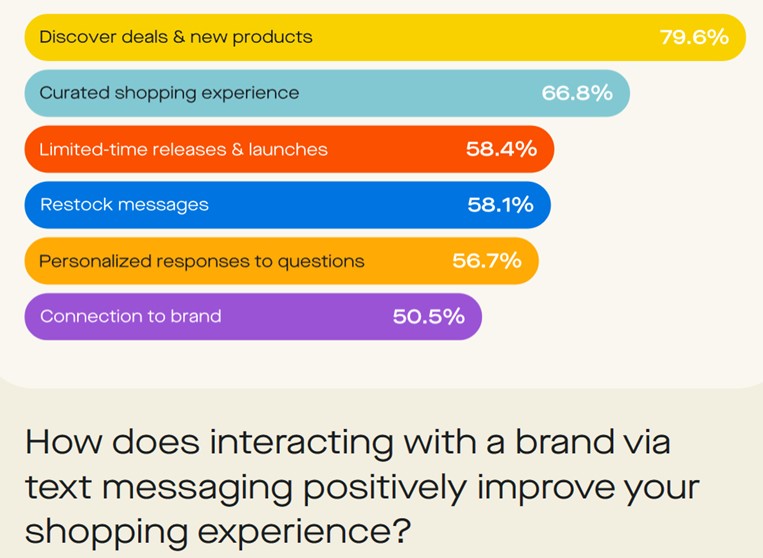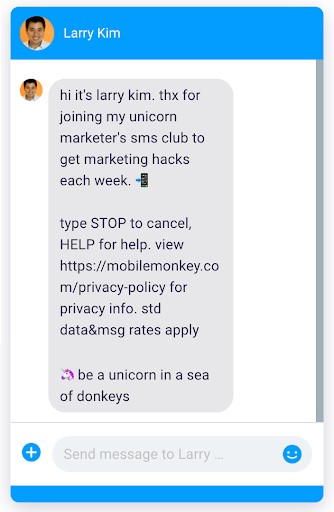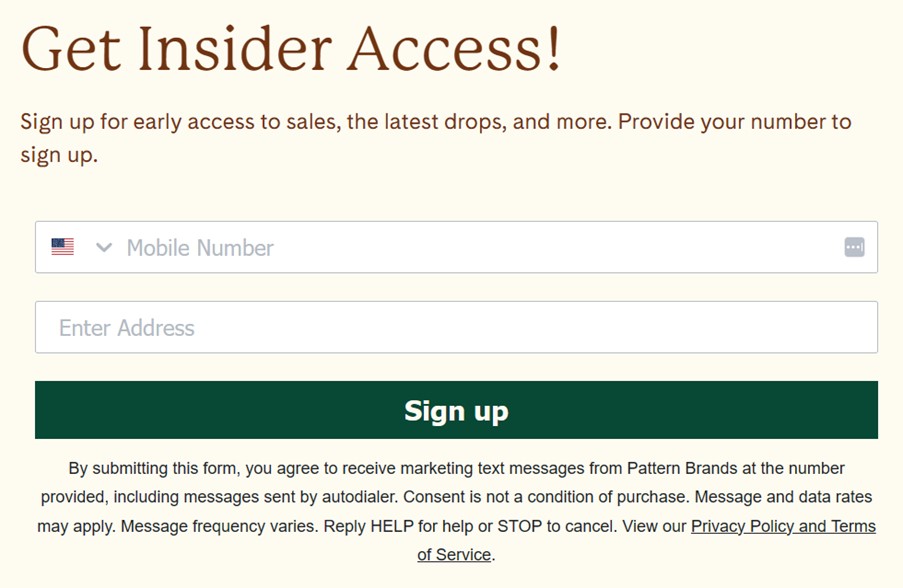Clean Ways To Get Numbers For SMS Marketing

Messaging without permission is illegal.
Maximising the number of leads for a short message service (SMS) marketing campaign is ideal. However, you need your leads’ express consent to message them, meaning you can’t just grab a list of numbers and start texting whoever you want.
SMS is a very intimate and important channel for consumers, so abusing your access can end in annoyance or even lawsuits.
The good news is 90% of people in the UK are interested to hear from brands via SMS.
You can get people on board to receive your texts, but the question needs to change from “how do I get numbers for SMS marketing?” to “how do I get numbers for SMS marketing legally and gain people’s trust?”
We’re glad you asked! We’ve got some actionable advice ready to help you get SMS marketing right.
Now, first things first…
Why You Can’t Just Buy a List of Phone Numbers and Bulk Send
Whatever you do, don’t listen to this guy:
Here’s why you can’t grab a random phone book (if you can still find one nowadays) or online contact list for marketing without express permission:
- You need written consent before you text people because if there’s a lawsuit, it’s on you to show proof you had permission
- If you break TCPA or GDPR regulations, you may get an initial warning or a fine, but if you keep breaking them, you’re at risk of class action lawsuits for continued abuse
- Lawsuits don’t only harm your company financially, but also reputationally, such as damages to your brand identity and consumer trust
- As a result, you can lose customers and have a harder time collecting new opt-ins
This may surprise you, so listen up:
You need to comply with the rules and regulations of the country your customers or leads reside in, not only your local regulations.
So, say you’re sending your SMS campaign from the UK, but a portion of your audience is in the US.
Legally, you would have to ensure you follow the US’s Telephone Consumer Protection Act (TCPA) regulations alongside the UK’s General Data Protection Regulation (GDPR) and other local laws.
The differences between various regions’ regulations aren’t huge, but they’re significant enough to get you in trouble if overlooked.
For instance, the TCPA (US) sees pre-checked consent boxes as a valid form of consent, while GDPR (UK) and most EU-based regulations consider them invalid.
Ignoring this minor difference can lead to an expensive problem down the line, especially in the case of a class action lawsuit.
The costs can max out at $20 million or 4% of your global revenue, whichever is higher.
For example, US Coachways paid $49.9 million dollars to settle the suit for sending unsolicited promotional messages to people who gave their contact for a quote but never agreed to receive additional messages in the future.
If you have an international SMS campaign, it’s best to stay on the safe side and ensure you comply with the most rigid regulations to mitigate the risks of any inconsistencies down the line.
So what are these rules, anyway? See the points below as rule-of-thumb guidelines, but also consider the regions you’re texting:
- Let people know exactly what they’re signing up for
- Require consent even if somebody else is doing the marketing for you because you’re still accountable as the instigator
- Offer (unchecked) consent boxes that specifically refer to SMS messaging, or have people text you a code word to opt in
- Ensure you have the permission for each number on any contact list you buy
- Provide the “opt-out” option with each message you send
- Stop sending messages as soon as the person unsubscribes
- Treat each marketing channel separately; don’t assume consent to an email newsletter automatically extends to SMS as well
That’s the legal context you need to even consider starting an SMS campaign.
Then, it’s time for part two: incentivising your audience to opt in and stick with you beyond that initial interaction.
9 Effective and Meaningful Ways to Get Phone Numbers for SMS Marketing
Many of these ideas are fairly obvious, and you’ve likely seen them used to get phone numbers for marketing, but there are huge differences between doing them well and falling short. So, what gives?
Often, this gap comes down to personalisation.
To illustrate, offering a generic discount might not entice a customer, but offering them a personalised discount on their favourite product might.
Let’s explore your options and talk about how to do them right.
1. Offer perks or discounts to subscribers
Perks and discounts are the number one reason why most people opt in for SMS marketing messages in the first place.
They’re also an excellent way to kickstart your campaign.
Many companies use perks as incentives.
Yet, some offers hit the bullseye while others fall short. As we mentioned earlier, the difference is in how much you personalise.
Personalisation may sound like too much work, but you’re likely already tracking the necessary data to calculate your ROI anyway. If not – here’s a reminder to start.
Think about your customer segmentation and interaction or purchase histories.
There’s a good chance you can find a few keys for each group of customers.
Further, you can set triggers that help you find the most relevant individual approach without wasting any time assessing your leads one by one.
Here’s an idea: when a customer purchases the same item twice or more, offer them a discount for it if they sign up for SMS marketing.
Guaranteed success.
Here are some other ideas:
- Tailored advice about the service they viewed on the site or one of their interests
- Free aeroplane miles for frequent flyers or fuel rewards for drivers
- Samples of a product that complements the one they already use
- Exclusive deals for subscribers or loyalty program members only
- Instructional content to help users get the most out of their service or purchase or learn about a topic they care about
A simple example:
Some people want to be a part of the VIP crowd. Others just like to make chores as convenient as possible.
You know your audience best – find and strike that special chord with them in your offers.
Just don’t pitch the same deal across the board.
2. Make offers time-bound
Create a sense of urgency to tap into FOMO and get those opt-ins while also giving something back.
Time-bound offers as simple as “Subscribe before this date to receive X% off” can work wonders. However, we can’t stress this enough: don’t be spammy with them.
If you keep sending customers urgent messages in all-caps every week, and you’re actually offering good deals all the time and not “this time only”, customers will interpret it as aggressive or disingenuous marketing unless that’s exactly what they signed up for.
Expect an equally intense response on their end.
On the other hand, exclusive flash sales for relevant products or discounts for offers could be just what a segment of your audience wants.
For example, WineText sends daily sommelier-picked deals to subscribers who can simply respond with the number of bottles they want and make a purchase via SMS.
It’s fast and convenient, and the offer’s expiry date drives engagement – if you snooze on an offer, you could lose the deal.
3. Offer personalised interaction-based service via SMS
SMS messaging doesn’t need to be one-sided.
People value responsive companies and generally prefer feeling like they’re speaking to a human, so 2-way texting is a good idea.
How about this: a mini quiz-type conversation where leads tell you about their needs, and you create a personalised offer or advice based on that information?
Everyone likes content that caters to them.
If you’re responsive, specific, and relevant with your offer to your target audience, you could even have them engage with you on their own accord and become their valued ally.
4. Host competitions requiring opt-in for entry
If you’re not sure how to get numbers for SMS marketing to begin with, requiring the opt-ins to participate in a competition is a piece of cake.
Depending on what kind of deal you use it in, this could be a hit or a miss. So, here’s some advice:
- Make your competition and the results relevant to the target audience
- Ensure the content in your offer and the content of your SMS campaign go well together
In other words, don’t require an opt-in for a makeup kit giveaway and then text those people about events at a local theatre – unless you can find a creative link between the two, like “show off your new eyeshadow on a local event”.
Otherwise, it will be a waste of time for everyone. You might get a high initial opt-in rate, but high opt-outs will also follow.
5. Include easy sign-up forms on your website and social channels
Use the channels and audiences you already have.
Highlight the SMS campaign on your website. Give it its own section and a CTA button that could be seen from miles away – it needs to be visible and enticing to visitors.
But don’t forget about your existing audience.
People who are subscribed to your email newsletter and already appreciate your content are more likely to find your SMS campaign valuable. The same goes for blog readers and social media followers.
Just remember, never assume people are automatically okay with SMS if they’ve consented to email. Always ask for each individual channel to stay on the good side of the laws.
To sum it up:
- Don’t: misuse the contact information people gave you by messaging them when they didn’t agree to it, even if they consented to receive other forms of marketing
- Do: mention your SMS campaign and provide a sign-up option in your email newsletter, on the website, and on your social media so existing audiences and new visitors can easily get on board
6. Focus on building a brand that people want to engage with
Let’s talk about your overall approach to marketing and your brand identity outside of your SMS campaign.
Having a solid brand presence is essential because:
- You want to portray a consistent image so people can know and trust you
- You need to have a voice and character for people to want to interact with you
In other words, if you’re bland or vague, nobody will have an opinion about your company, and business-wise, that’s not as safe of a stand as it seems.
There are multiple ways you can make yourself an interesting brand to follow. Think about brands you like. Why do you like them?
Maybe you like Oatly for their cheeky columns found on the side of their plant-based milk cartons.
Perhaps you like Userpilot solely because you follow Emilia Korczynska on LinkedIn.
We don’t blame you, she posts some crazy insightful content.
But back to you – here are things you can think about to help you build trust and stand out:
| Ideas to build your brand | How to do it |
|---|---|
| Unique, clever, and convincing copy |
|
| Focus on providing value to your niche audience |
|
| Show your human side |
|
| Don’t forget testimonials |
|
These steps can help you build a brand that people want to hear from.
7. Be 100% honest about your SMS guidelines: what you send and when
It’s up to you to set the tone for the SMS campaign so people don’t jump to their own conclusions.
To create a solid base for a positive customer relationship, you need to be transparent about what the campaign entails:
- What are the messages about?
- How often are you texting subscribers?
- What are the benefits of opting in?
These things need to be clear before the audience even receives the initial text.
Providing that information as soon as you mention that you have an SMS campaign helps people gauge whether they should be on your list, and staying true to your word helps them start trusting you.
8. Provide options as to what the customer allows you to text them about
Personalised ads show us that people want relevant and convenient options catered to them.
BuzzFeed quizzes like “Which type of onion are you?” have demonstrated the lengths we as a species go to feel unique and special while also belonging to a group.
You can focus your SMS campaign around those desires and needs by customising the text sequences your leads receive instead of blasting out uniform campaigns.
Start by segmenting leads into groups.
Demographics, history with the brand, previous purchases, loyalty, and other distinguishing characteristics can be your guidelines.
But do you know what’s going to give you the best personalisation criteria by far and save you time?
Your audience’s choices.
Give your audience multiple topic options to choose from. They can tell you everything you need to know and help you send the most useful texts without having to call your local seer or whip out a Magic 8 Ball.
Just explain the rationale and the options on your sign-in screen or section.
Merely knowing that they’ll be able to influence the campaign and get tailored messages can sway people to opt in because that makes the campaign more about them.
- “Choose a service you’d like to hear about the most”
- “Take this short survey to ensure you get the information most relevant to your needs”
- “Tell us a bit about you so we can give you tailored advice”
This strategy applies to everything from matching makeup to skin tones, to finding the perfect summer reads, to planning the best vacation ever using your SMS service.
Delivering on your promise makes them stick around.
9. Partner with a text messaging service that can help you
Which messaging provider should you choose?
You need to know how they’re different besides the costs.
Some providers can’t reach people in other countries, automatically limiting your pool of options.
Integrations are also important because let’s face it, SMS marketing probably isn’t the only thing you’re doing – the campaign needs to align with your other marketing efforts.
To integrate your SMS marketing with the rest of your business, you need a way to transfer customer information – interaction history and such – from a CRM or other tool to avoid having to do it manually every time you want to text your prospects.
Finally, personalised support is one of the most valuable assets you can get from your provider to ensure you’re on the right track and getting the most out of your SMS marketing.
A solid provider focuses on these elements and maximises your reach.
How To Get Numbers for SMS Marketing the Right Way
Remember, unsolicited marketing messages are illegal.
But even if you’re compliant with all the rules and regulations, there’s still a lot of room on the spectrum between legal-but-annoying and clever, helpful, or spot-on content that people actually want in their inboxes.
Why should you care? It’s simple: the opt-in is never the end goal.
For a long-term positive relationship with your audience, you have to hook them by being transparent, relevant, and memorable, then build from there.
It’s not a walk in the park, but SMS messaging isn’t rocket science either, especially with a trusted partner who can help you build, clean up, and maintain your SMS database.
Contact Mr Messaging to get personalised support every step of the way.



